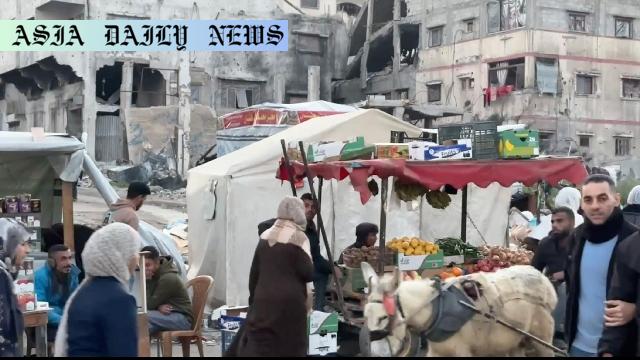Ramadan begins amidst Gaza’s ruins, with hope for peace and survival.
Keyword: Ramadan
Key Point 1: The ceasefire in Gaza coincides with the holy month of Ramadan, offering a glimmer of hope amidst shattered lives.
Key Point 2: Food aid distribution has reached about half the Gaza population, but many still lack access.
Key Point 3: Residents describe hardships, including loss of loved ones, destroyed homes, and limited resources.
Key Point 4: Despite adversity, families prepare for Ramadan as a time of prayer and resilience.

Introduction
Ramadan 2023 has dawned upon the residents of Gaza under extraordinary circumstances. This Muslim holy month, typically marked by fasting, prayer, and family gatherings, now takes place amidst the ruins of destruction caused by prolonged conflict and hardship. The temporary ceasefire between Israel and Hamas has given a momentary reprieve, but the scars of war remain visible in every corner of the district. For many in Gaza, this Ramadan is a poignant reminder of resilience and survival rather than celebration.
The Current Humanitarian Landscape
As an enclave already enduring significant economic disparity, Gaza faces amplified challenges this year. According to the World Food Programme, food aid has reached approximately one million individuals, a stark figure considering it constitutes nearly half of Gaza’s population. However, complications in distribution, damaged infrastructure, and ongoing security risks mean that some residents remain cut off from critical support. Bread is slowly becoming available as bakery operations begin to resume, yet for many families, meals remain sparse during this sacred time.
Ordinary citizens have shared their despair. One elderly man reflected on the absence of joy this Ramadan, describing a life without access to fundamental needs: food, water, and education. Despite the ceasefire, the impact of the war has decimated opportunities for employment, leaving numerous families in poverty. Many are still sheltering in temporary tents, mourning the loss of their homes and loved ones. Ramadan, often a symbol of hope and communal strength, is this year stained by harsh realities.
Preparing for Ramadan Amid Rubble
Despite the adversity, some semblance of normalcy and preparation for Ramadan can be observed. At an outdoor market amidst the rubble of Gaza City, vendors display fruits and modest goods for sale. Families purchase what little they can afford, driven by faith and a yearning to keep traditions alive. These acts of preparation signify more than just routine; they embody the human spirit’s drive to adapt and persevere.
The significance of Ramadan for Muslims extends beyond the physical act of fasting. It is a time of reflection, unity, and charity. In Gaza, these elements take on an even deeper meaning. Despite limited resources, sharing meals among families and fasting together strengthens communal bonds that have been fractured by conflict. One elderly resident expressed his wish for a peaceful Ramadan and a lasting end to warfare, sentiments echoed by many others in the area.
Looking Forward
As Ramadan unfolds, the fragile ceasefire remains a symbol of hope for a better future. It is crucial for global powers and humanitarian organizations to step up efforts to ensure aid reaches all corners of Gaza. Rebuilding homes, schools, and hospitals must become a priority once the ceasefire solidifies. For the people of Gaza, the holy month is a reminder that faith and prayers can outlast suffering, but tangible changes are needed to restore any semblance of stability.
Ultimately, Ramadan in Gaza this year is not just about the act of abstaining from food and drink; it is a testament to the enduring human capacity for hope, even in the face of unimaginable hardship. While the shadows of war linger, the people of Gaza continue to navigate their lives with resilience. Their faith holds strong, as does their plea for a future free from conflict and suffering.



Commentary
Reflections on Ramadan in Gaza
The commencement of Ramadan in Gaza amidst such devastating circumstances evokes profound reflections on human resilience and the strength of faith. Amidst the rubble and grief, the people of Gaza continue to uphold the traditions of Ramadan with dignity and resolve. This alone is a testament to their unwavering courage and determination to preserve their cultural and religious heritage, even when confronted with overwhelming challenges.
One cannot ignore the stark contrast between the spiritual essence of Ramadan and the grim realities faced by Gaza’s residents. This sacred time, meant for unity, introspection, and blessings, is overshadowed by dire humanitarian needs. Stories of families struggling to find joy amidst the ruins serve as heart-wrenching reminders of the consequences of prolonged conflict. Yet, even in such bleak conditions, the community’s acts of preparation, fasting, and prayer signify hope, resilience, and a collective striving for better days.
The Role of the Global Community
Beyond mere observation, the global community has a moral responsibility to respond to the circumstances in Gaza. Humanitarian organizations are playing a key role in mitigating the crisis, but their efforts are hindered by logistical and political challenges. The renewed focus on assistance must go beyond short-term relief and pave the way for sustainable solutions. Reconstruction efforts, international negotiations for lasting peace, and consistent aid distribution will be vital to uplift the people of Gaza.
The stories emerging from Gaza during Ramadan should not just evoke sympathy but inspire action. All efforts to restore dignity and provide support must respect the resilience and strength that the people have shown. In their ability to hold onto faith and community during Ramadan lies a lesson that transcends borders: the enduring power of hope and the universal desire for peace.